While many adults engage in sports, even more children participate in sports (Blendon et al., 2015). A 2020 report suggests that over 50% of children between 6-17 have participated in sports within the last year (Black et al., 2022), which is an increase from under 10% of children who engaged in sports in the early 1970s (The National Federation of State High School Association, 2022).
With more than 3.5 million sport injuries estimated to occur each year (Johns Hopkins Medicine, 2023), Truveta Research spent the last several weeks exploring and describing injury patterns related to various sports – basketball, soccer, baseball/softball, and football – and most recently, an analysis of people who experienced more than one injury reported within the hospital. Our analyses yielded interesting and varying results by sport, so we set out to compare the injury results across sports. As we wrap up this series, we were curious to learn about differences in demographics for the population who experienced injuries and which sports had the highest rate of injuries impacting certain body parts.
We found that amongst people with injuries in each sport, football had the highest rate of injuries for those under 18 and the highest rate of injuries that involved concussions/traumatic brain injuries (TBIs). Baseball players had the highest rate of face and head injuries by more than double. When stratifying by sex, females with soccer injuries had the highest rate of concussions/TBI (higher than football).
Methods
We defined sport-related injury encounters using a subset of ICD-10 codes. Using a subset of Truveta data, we identified nearly 100,000 people with more than 120,000 sport-related injury encounters.
We compared the age, sex, race, and ethnicity of those injured (race and ethnicity have been added from our original analysis). We also looked at the location of the encounter to understand how people engaged with the health care system when injuries occurred.
Finally, we classified the body parts that were injured or affected during the basketball injury. We found the diagnostic codes that were associated with the same encounter as the injury and classified them into 13 categories according to injury location (cardiac/chest, concussion/TBI, face/head, groin, lower extremity, neck/back, pain in unspecified location, trunk, upper extremity, other location, unrelated to place of injury on the body). For this analysis, we excluded diagnoses that were classified as ‘other location’ or ‘unrelated to place of injury on the body.’ We also excluded a small set of injuries that were associated with multiple sports.
Results
In this subset of Truveta data, the majority of injuries were related to basketball (36.3%). Football injuries comprised the second highest percentage of injuries (26.5%), and baseball/softball and soccer both comprised 18% of injuries.
It’s important to note that there may be differences between the percentage of people who are engaging in sports and those who are getting injured (Hanson et al., 2005; Harmon et al., 2018).
Who made up the injured populations?
Football had the largest number of injuries amongst the population under 18-years-old (over 80%), while all other sports had less than 66% of injuries affecting adolescents.
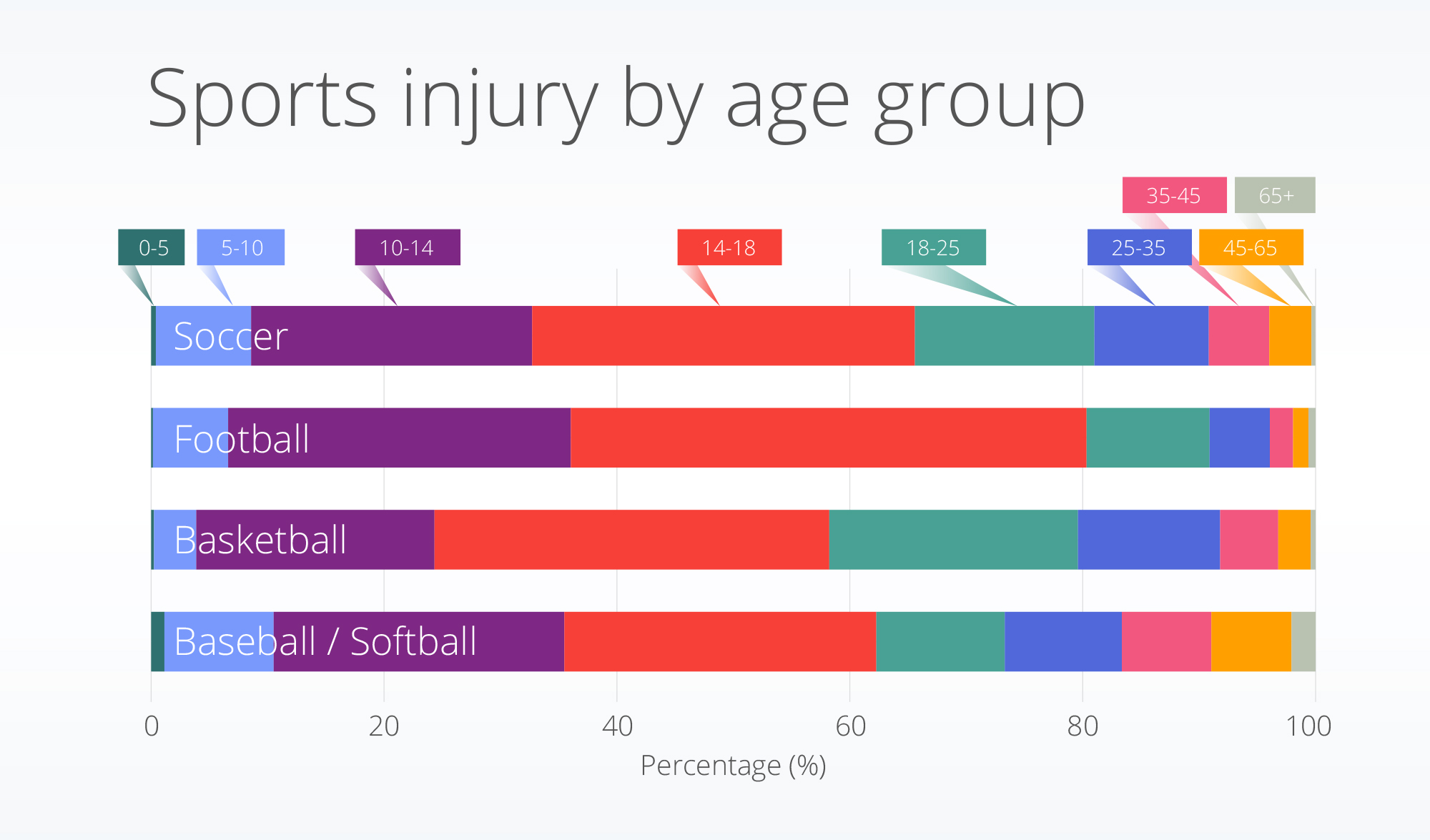
All sports had more male injuries than female injuries. Soccer and baseball/softball had the highest percent of female injuries (33.2% and 32.3%, respectively). With less than 10% of injuries affecting females, football had the smallest percentage of female injuries.
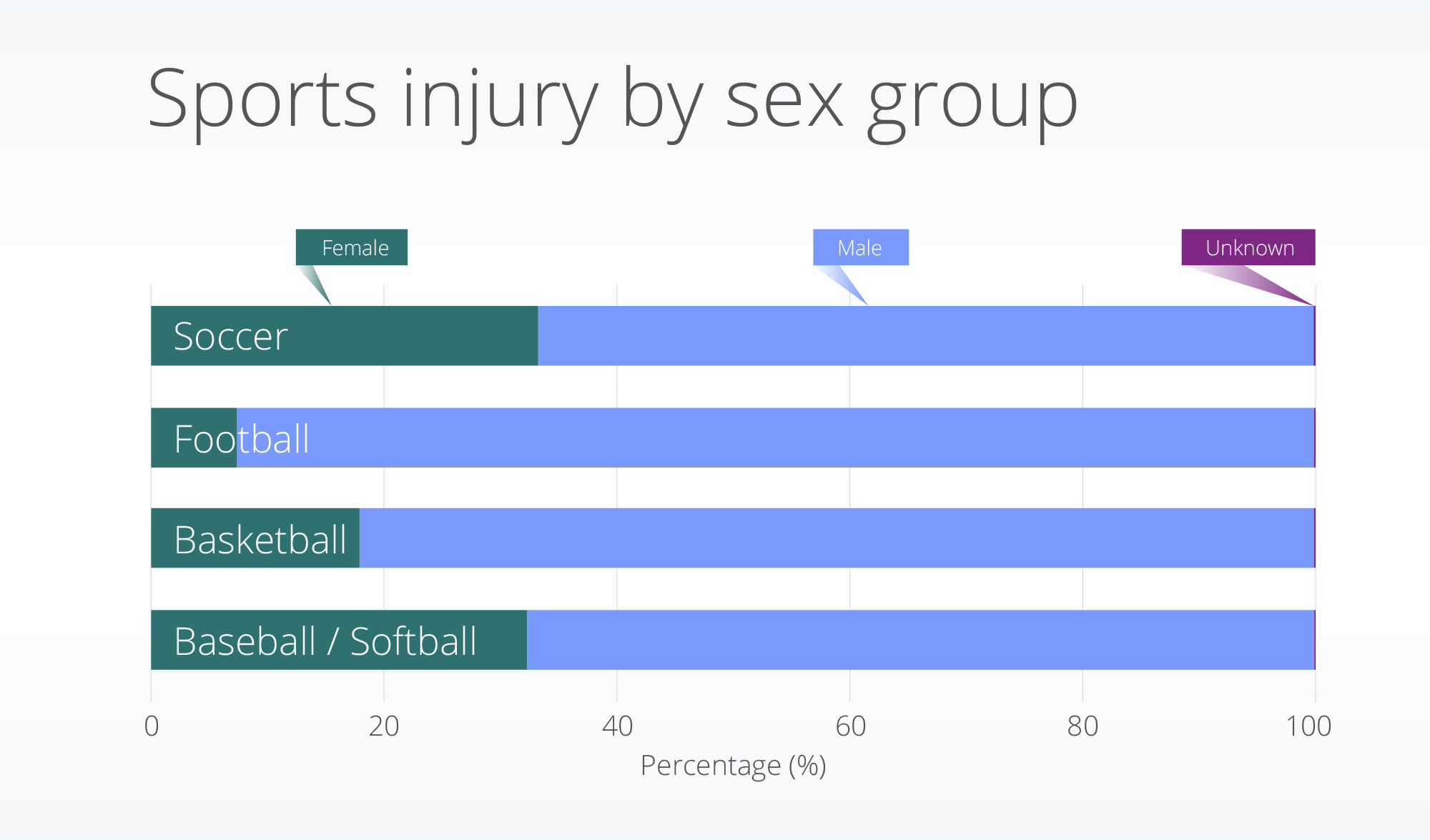
When examining the injured population by race and ethnicity, there is variation in the percent of race or ethnic groups with a sport injury. Soccer had the highest percentage of injuries amongst people who identified as Other Race and Hispanic or Latino. Baseball/softball had the highest percentage of injuries amongst people who were of white race, and basketball had the highest percentage of injuries amongst Black or African American people (henceforth referred to as Black).
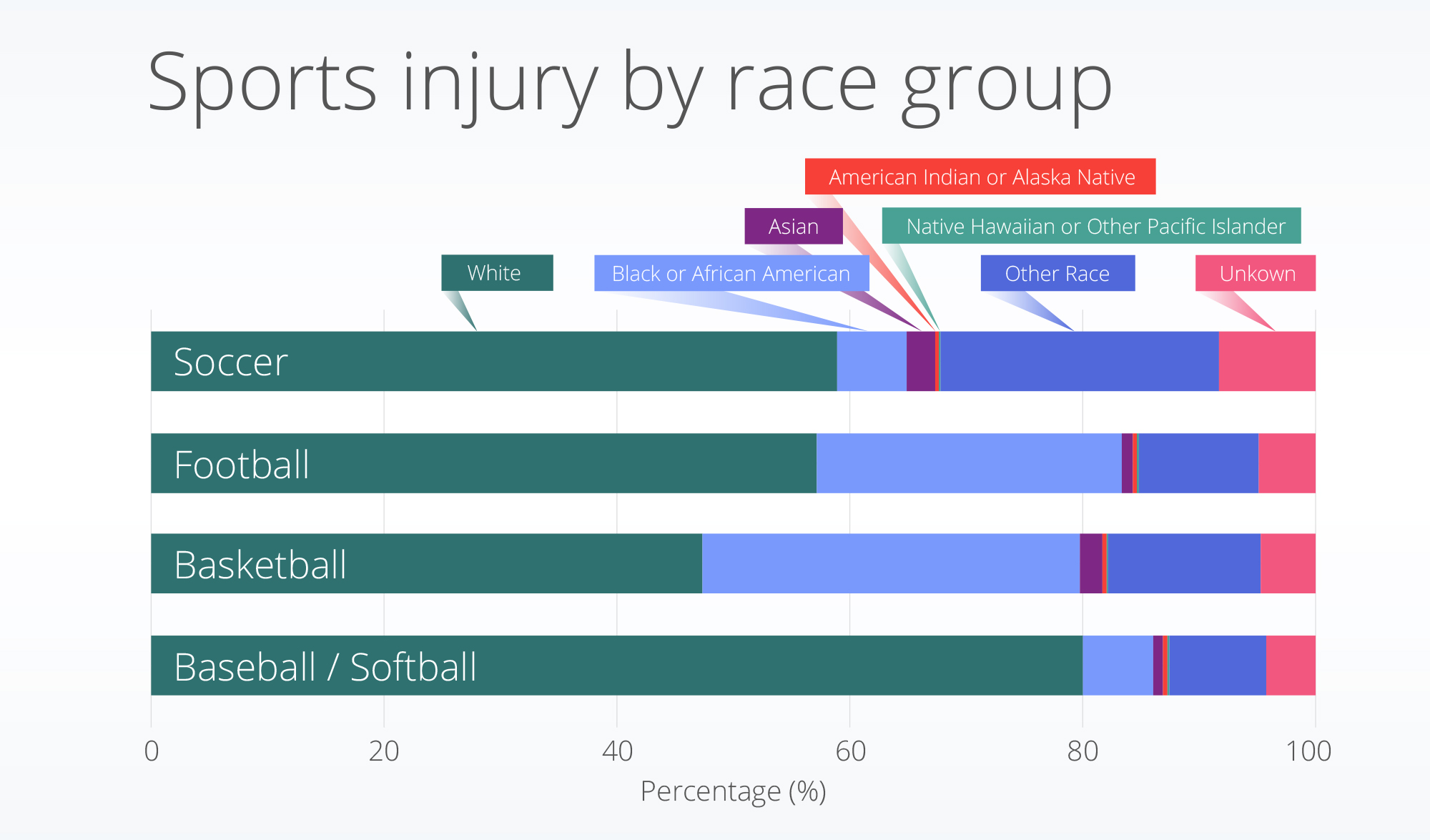
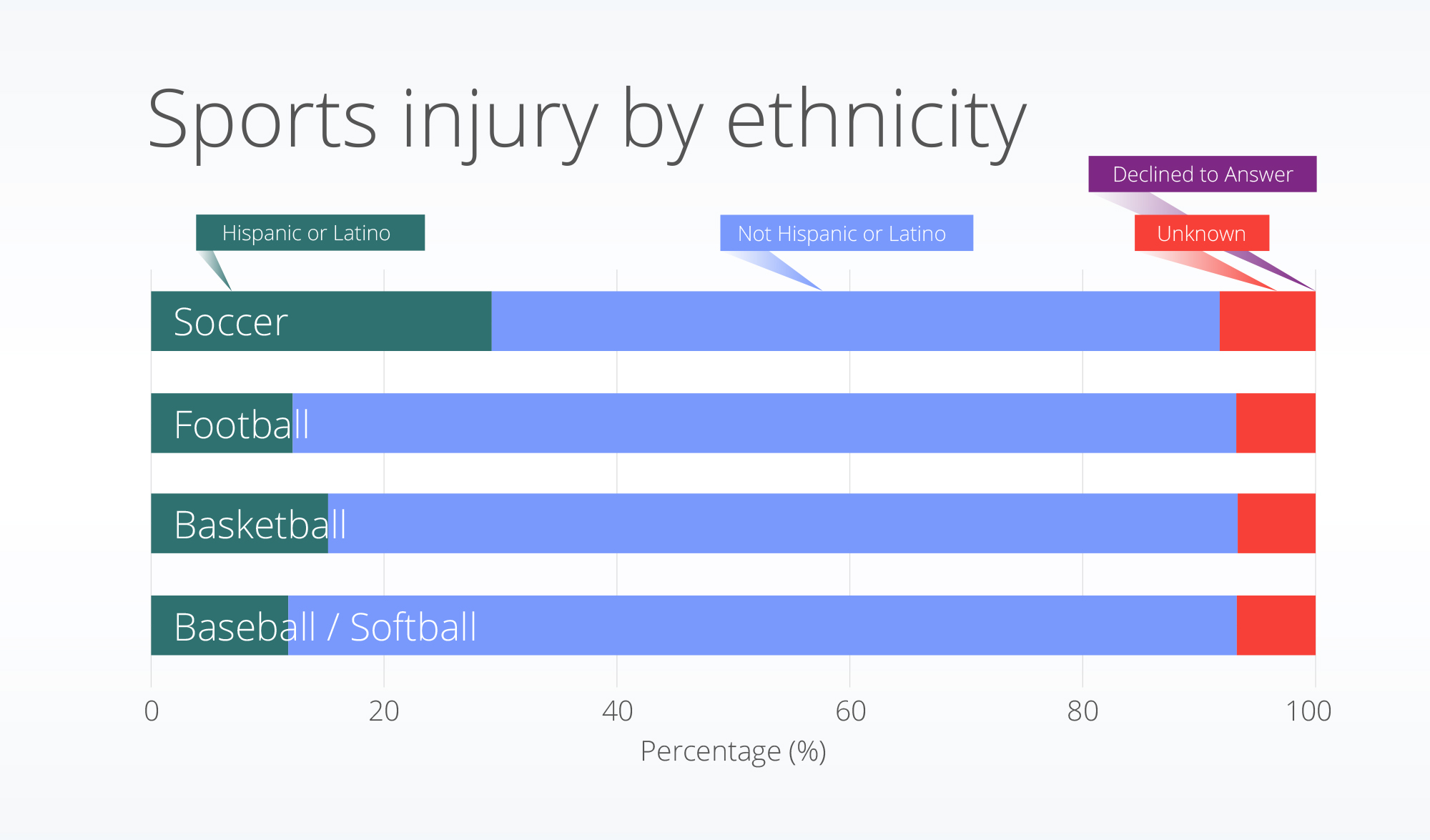
What body part was most often injured?
Amongst the people who had injuries, football had both the highest percentage of concussion/TBI, trunk, cardiac/chest, and upper extremity injuries. Baseball had the highest rate of face and head injuries; the rate was more than 15% more than any other sport. The lower extremity injury rate was highest in basketball. Concussions/TBI injuries were highest for female soccer players at 11.5%; the next highest sport was baseball/softball at 7.7%.
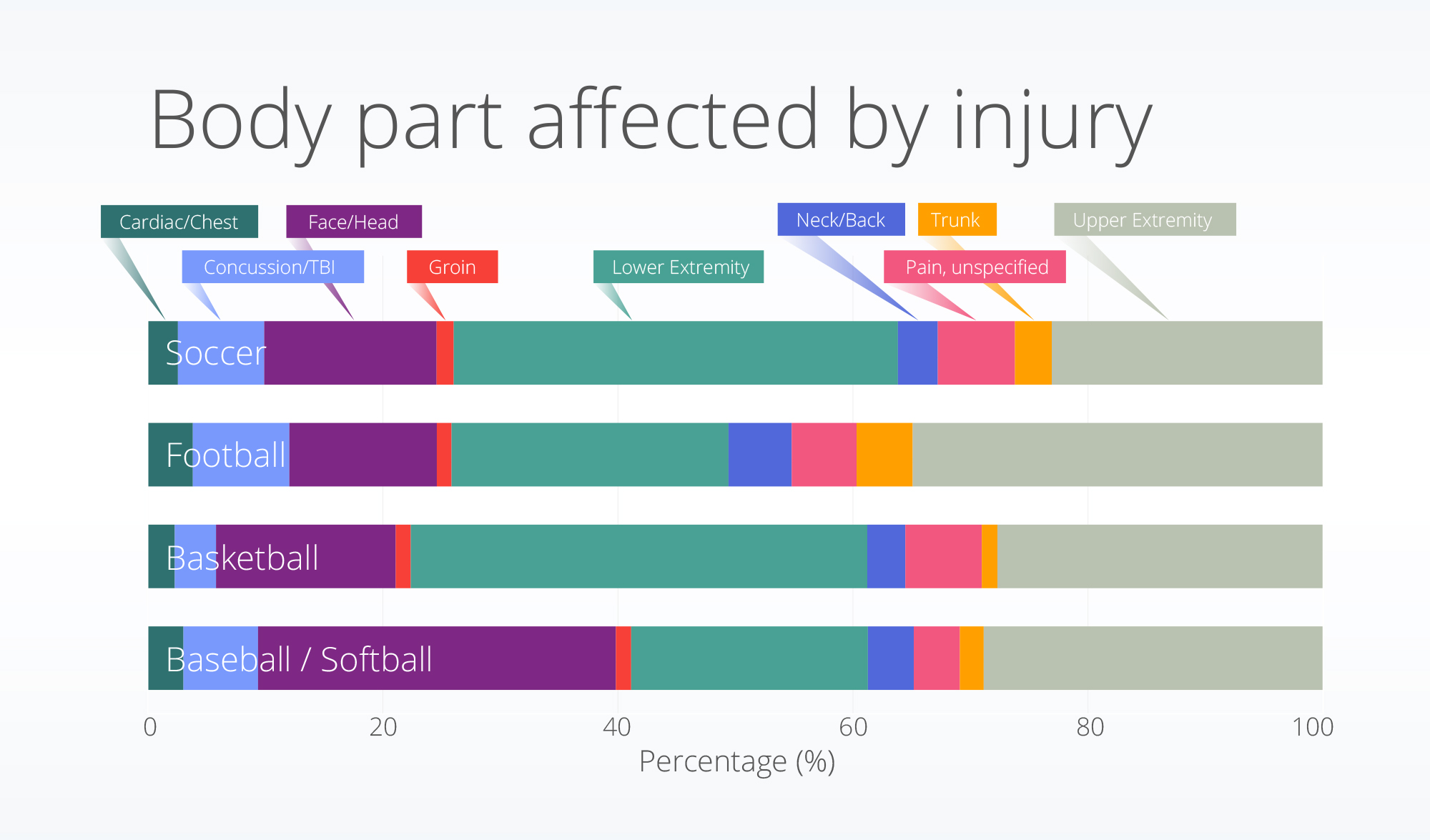
Discussion
Because so many people engage in sports throughout their lifetime, it is important to understand who is affected by injuries, and when they are injured, to understand the location of injury, severity, where they seek care, and the outcomes. There may be other factors at play for both who plays sports and who goes to the hospital after getting injured (Black et al., 2022). Variation in demographic groups could be explained by varied participation rates in sports by race or ethnicity. In particular, US-born Black players make up a very low percentage of people playing baseball (Brown & Gamble, 2022; Solomon, 2021), whereas Hispanic players (not race specific) make up roughly 30% of Major League Baseball players (Statista, 2023b). Other factors may also influence the frequency and severity of injury such as the surface the sport was played on (turf vs. grass) and the weather conditions during the sports event (if played outside) (DeArdo, 2023; Ekstrand et al., 2011; Rao & Mohan, 2021). Although injuries can be a part of physical activity, combing additional third-party data with the Truveta Data of people with sports injuries may aid in unveiling new analyses and results that could inform guidelines and recommendations to understand and reduce the impacts of injuries.
One limitation in this analysis is that we only included a subset of sports in our analysis. Notably, according to the National Federation of State High School Association (NFSH), outdoor track and field had the most female participants and the second to most male participants; track and field was not included in our analysis (The National Federation of State High School Association, 2022). Additionally, we relied on a subset of ICD-10 codes to identify sports injuries. If a physician didn’t code the sport injury, it may have been missed in our analysis. Future research is needed to understand the variation in race and ethnicity in sport injuries (Baker et al., 2021). Future research is also needed to account for potential differences in the Truveta population who experience injuries and a national sample who experience sports-related injuries.
As we conclude this series on sports injuries, we look forward to being able to further dig into these data with further analyses in the future.
These are preliminary research findings and not peer reviewed. Data are constantly changing and updating. These findings are consistent with data pulled January 11, 2023.
Citations
Baker, C., Chinaka, O., & Stewart, E. C. (2021). The time is now: Why we must identify and address health disparities in sport and recreation injury. Injury Epidemiology, 8(1), 25. https://doi.org/10.1186/s40621-021-00320-2
Black, L. I., Terlizzi, E. P., & Vahratian, A. (2022, August). Organized Sports Participation Among Children Aged 6–17 Years: United States, 2020. Centers for Disease Control and Prevention; National Center for Health Statistics Home. https://www.cdc.gov/nchs/products/databriefs/db441.htm
Brown, J., & Gamble, J. (2022, November 2). Major League Baseball has a diversity problem, experts say. This year’s World Series is proof. https://www.wlfi.com/news/national/major-league-baseball-has-a-diversity-problem-experts-say-this-years-world-series-is-proof/article_8fa60380-9ba8-5014-9765-d121cbea6b5c.html
DeArdo, B. (2023, April 20). NFLPA president says 2022 season data proves natural grass is “significantly safer surface” than turf. https://www.cbssports.com/nfl/news/nflpa-president-says-2022-season-data-proves-natural-grass-is-significantly-safer-surface-than-turf/
Ekstrand, J., Hägglund, M., & Fuller, C. W. (2011). Comparison of injuries sustained on artificial turf and grass by male and female elite football players: Playing elite level football on artificial turf. Scandinavian Journal of Medicine & Science in Sports, 21(6), 824–832. https://doi.org/10.1111/j.1600-0838.2010.01118.x
Hanson, D., Hanson, J., Vardon, P., McFarlane, K., Lloyd, J., Muller, R., & Durrheim, D. (2005). The injury iceberg: An ecological approach to planning sustainable community safety interventions. Health Promotion Journal of Australia, 16(1), 5–10. https://doi.org/10.1071/HE05005
Harmon, K. J., Proescholdbell, S. K., Register-Mihalik, J., Richardson, D. B., Waller, A. E., & Marshall, S. W. (2018). Characteristics of sports and recreation-related emergency department visits among school-age children and youth in North Carolina, 2010–2014. Injury Epidemiology, 5(1), 23. https://doi.org/10.1186/s40621-018-0152-0
Johns Hopkins Medicine. (2023). Sports Injury Statistics. Health. https://www.hopkinsmedicine.org/health/conditions-and-diseases/sports-injuries/sports-injury-statistics
Rao, V. L., & Mohan, N. V. (2021). Impact of weather on sports and sport injuries. Int. J. Phys. Educ. Sports Health, 8, 9–13.
Solomon, J. (2021, October 6). Out at Home: How High Costs and Low Representation Prevent Black Youth From Playing Baseball. https://globalsportmatters.com/youth/2021/10/06/high-costs-low-representation-black-youth-baseball/
Statista. (2023). Share of players in the MLB in 2022, by ethnicity. https://www.statista.com/statistics/1310428/racial-diversity-mlb-players/
The National Federation of State High School Association. (2022). High School Athletics Participation Survey. https://www.nfhs.org/media/5989280/2021-22_participation_survey.pdf
